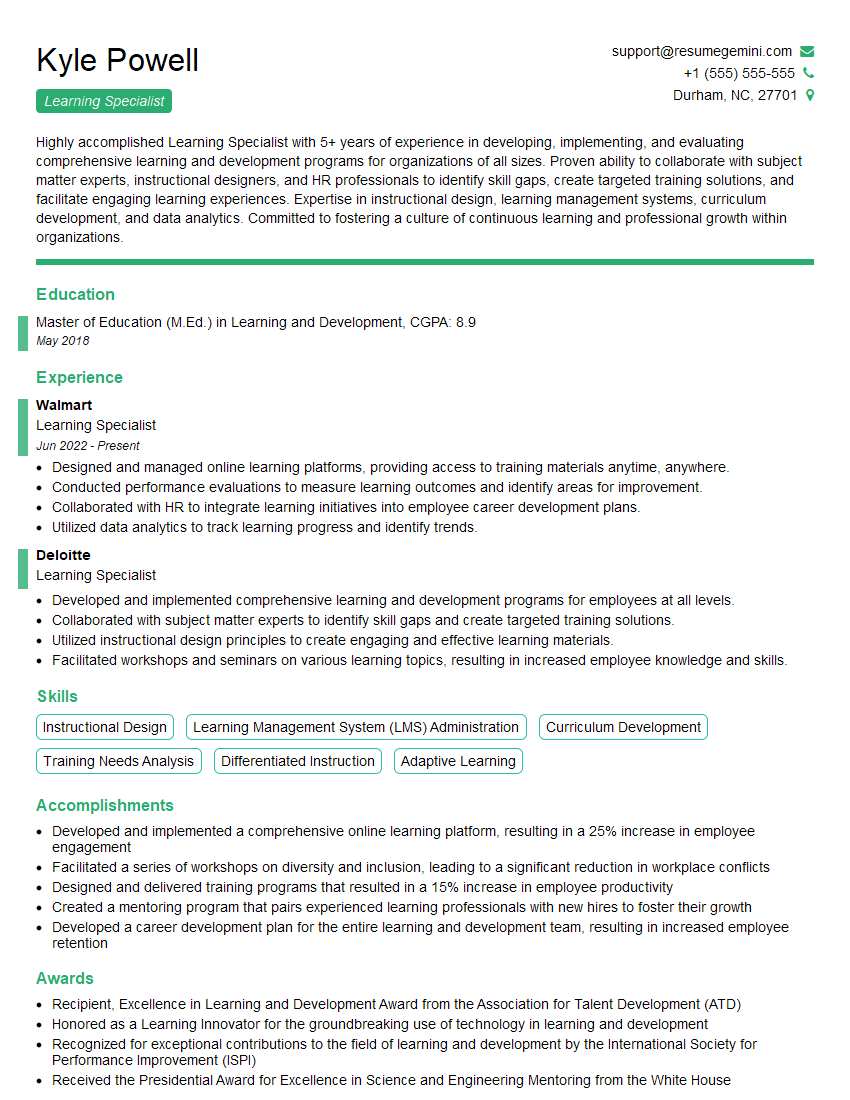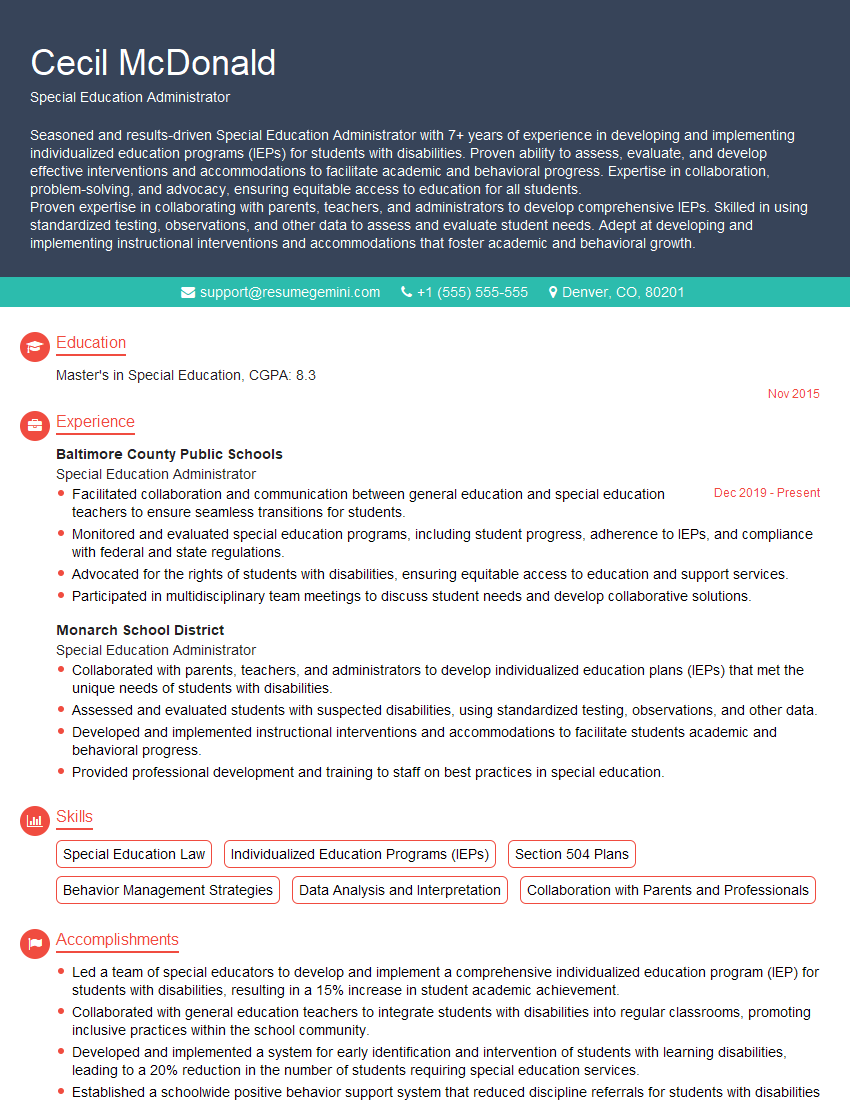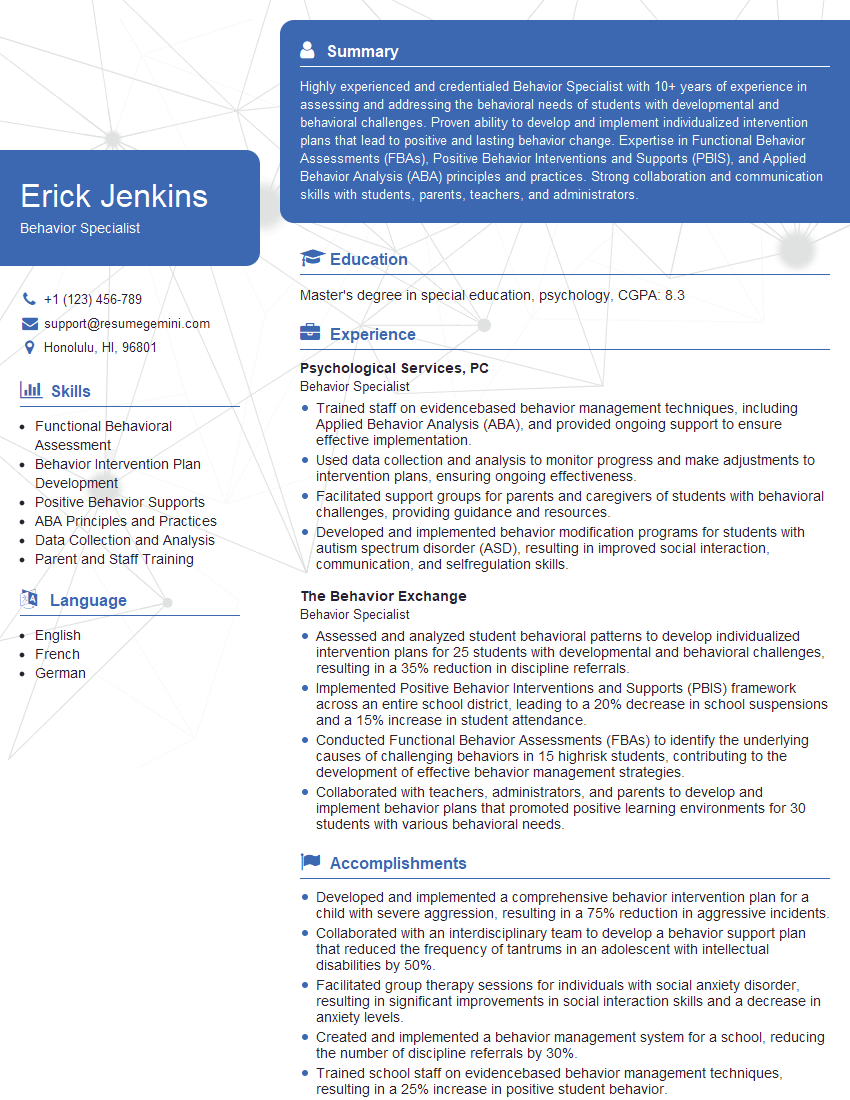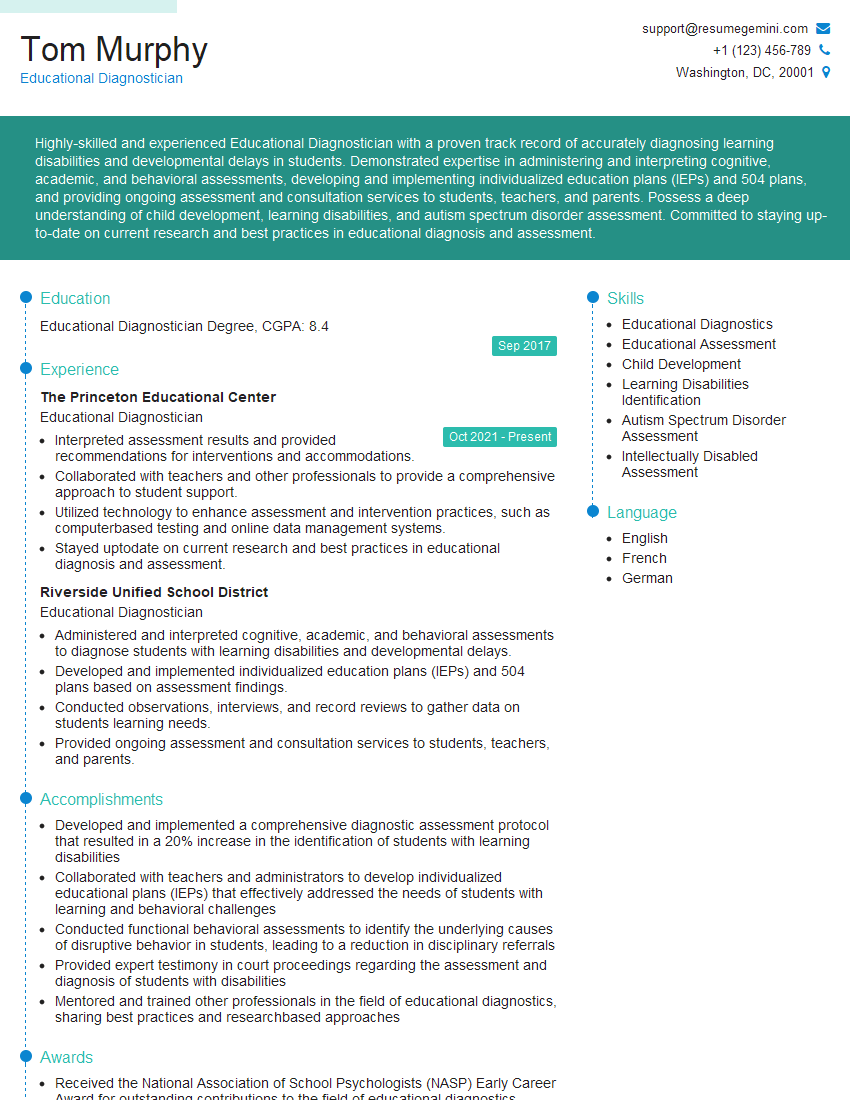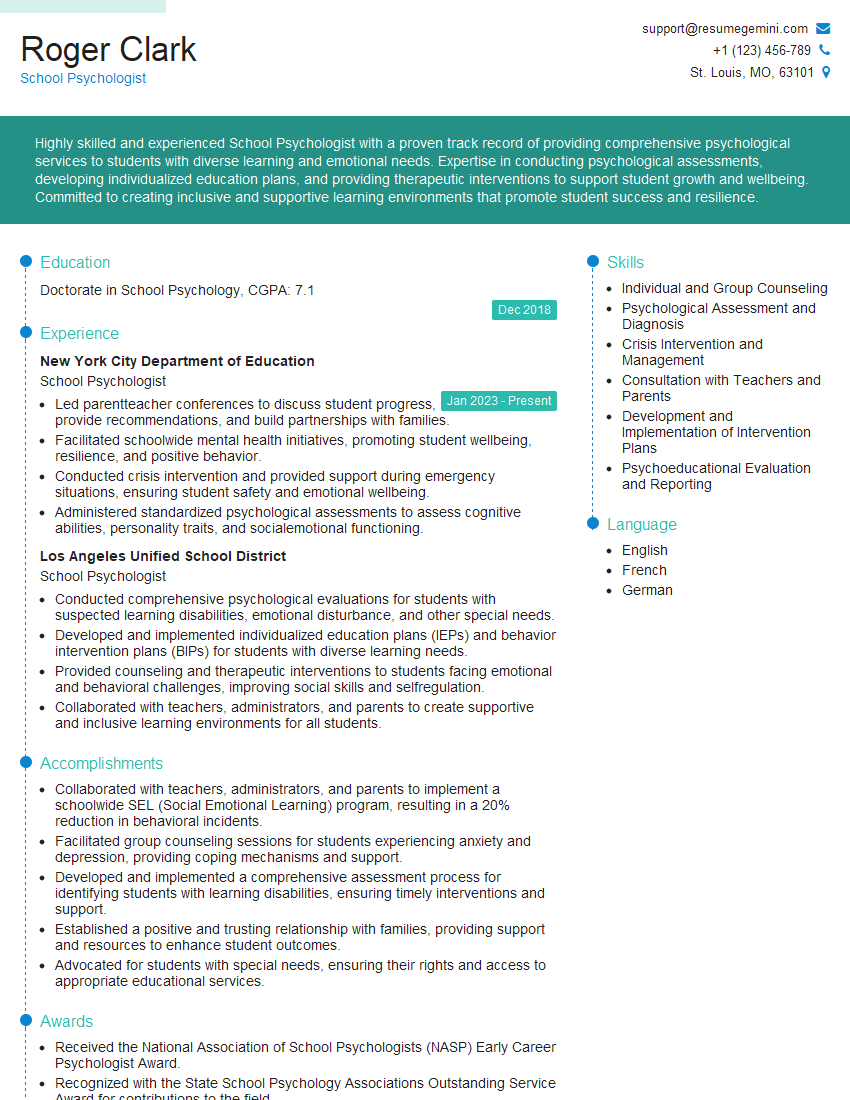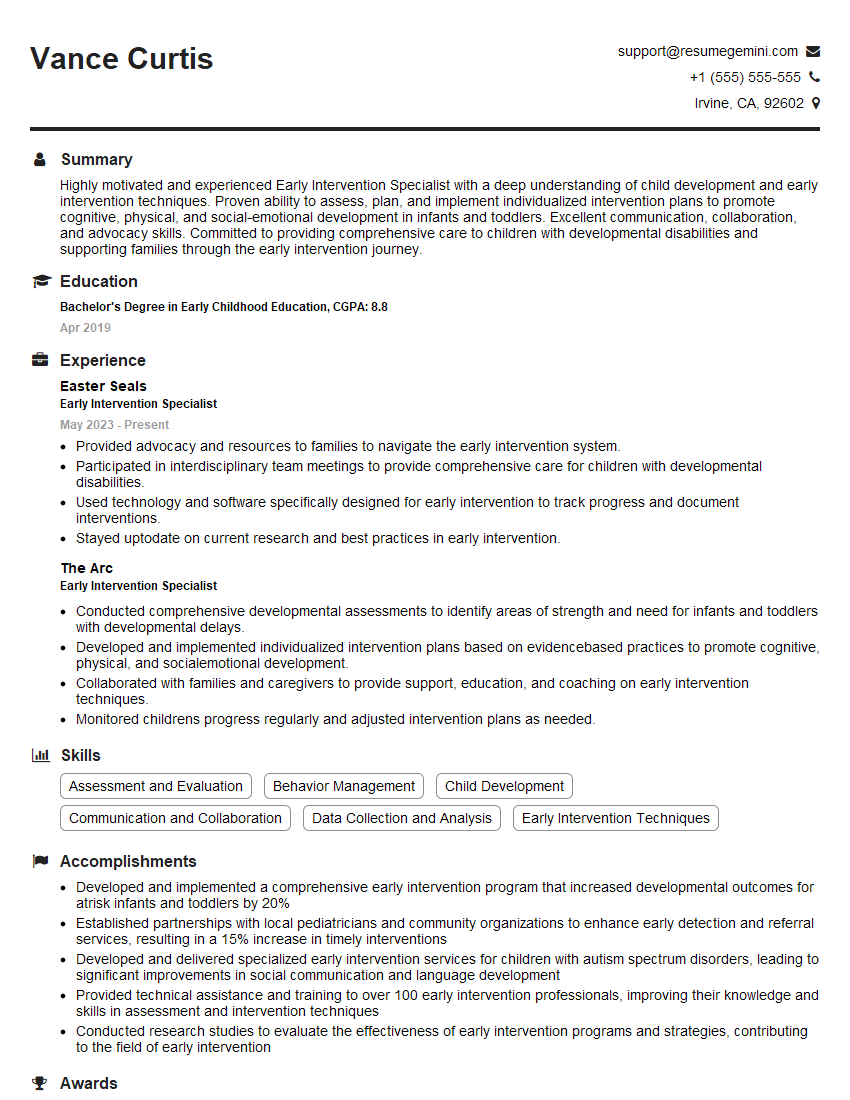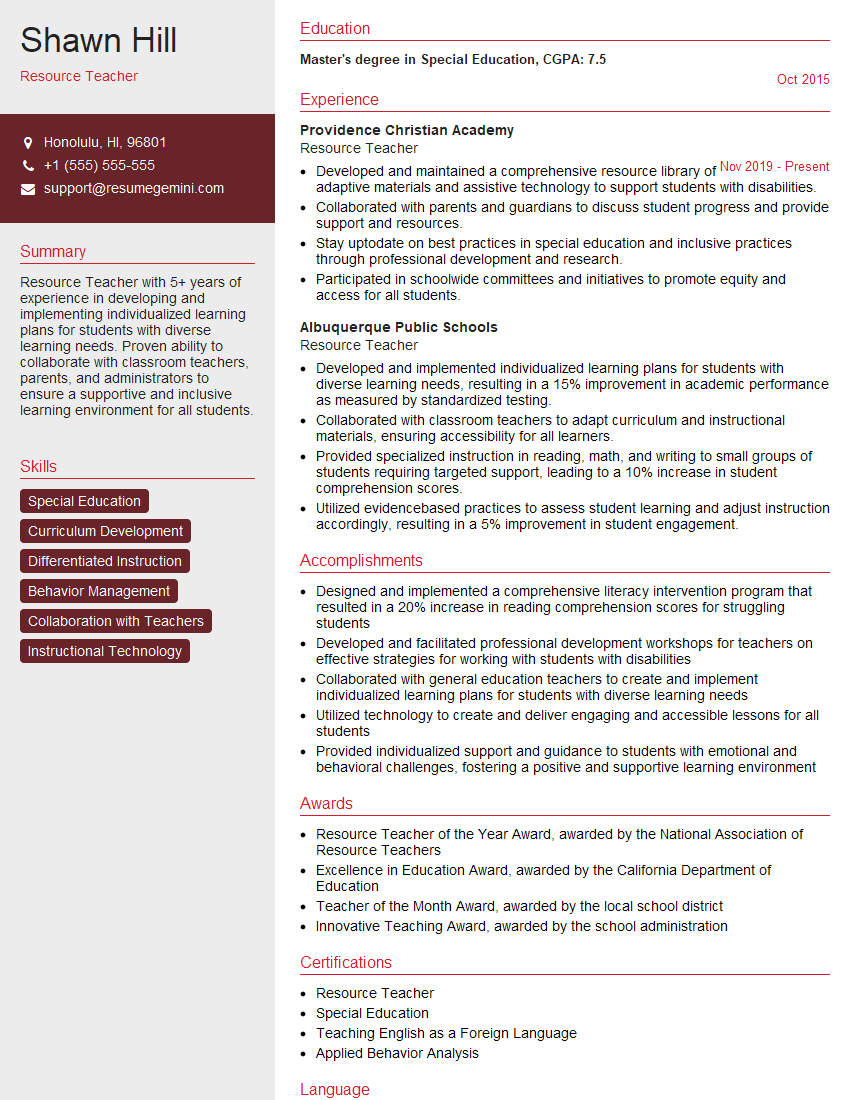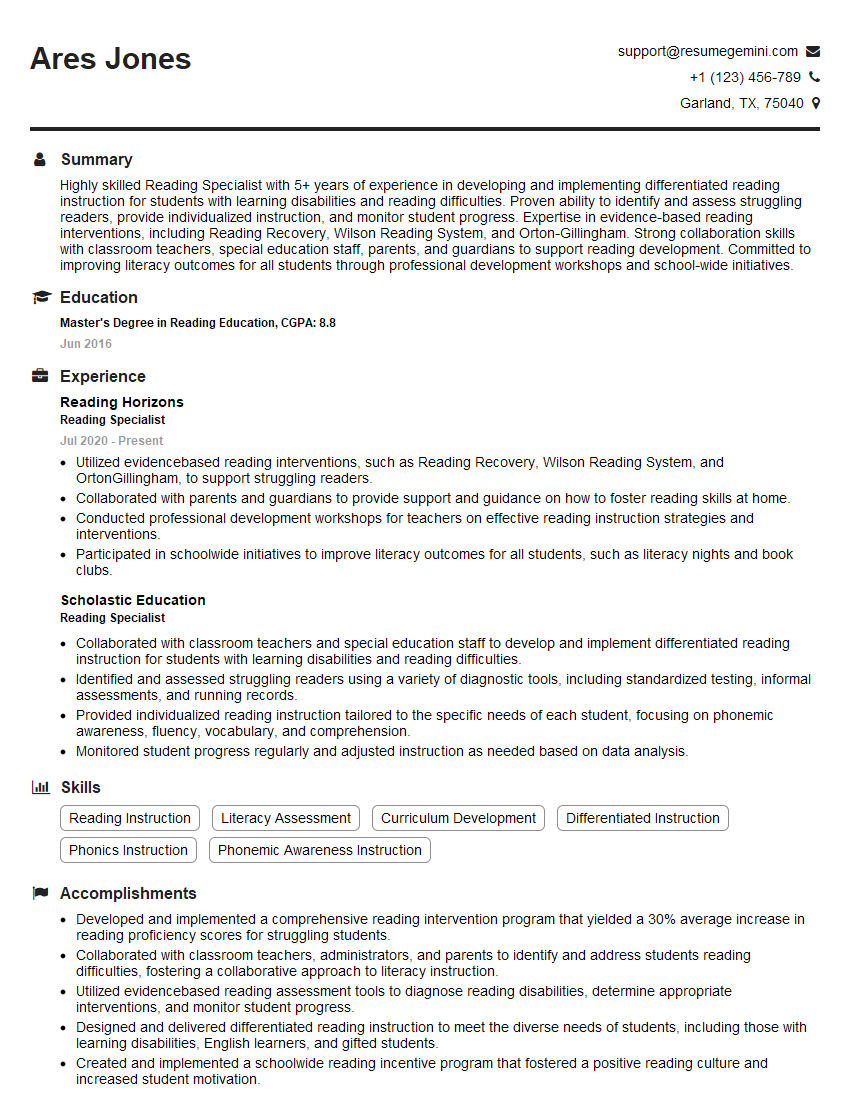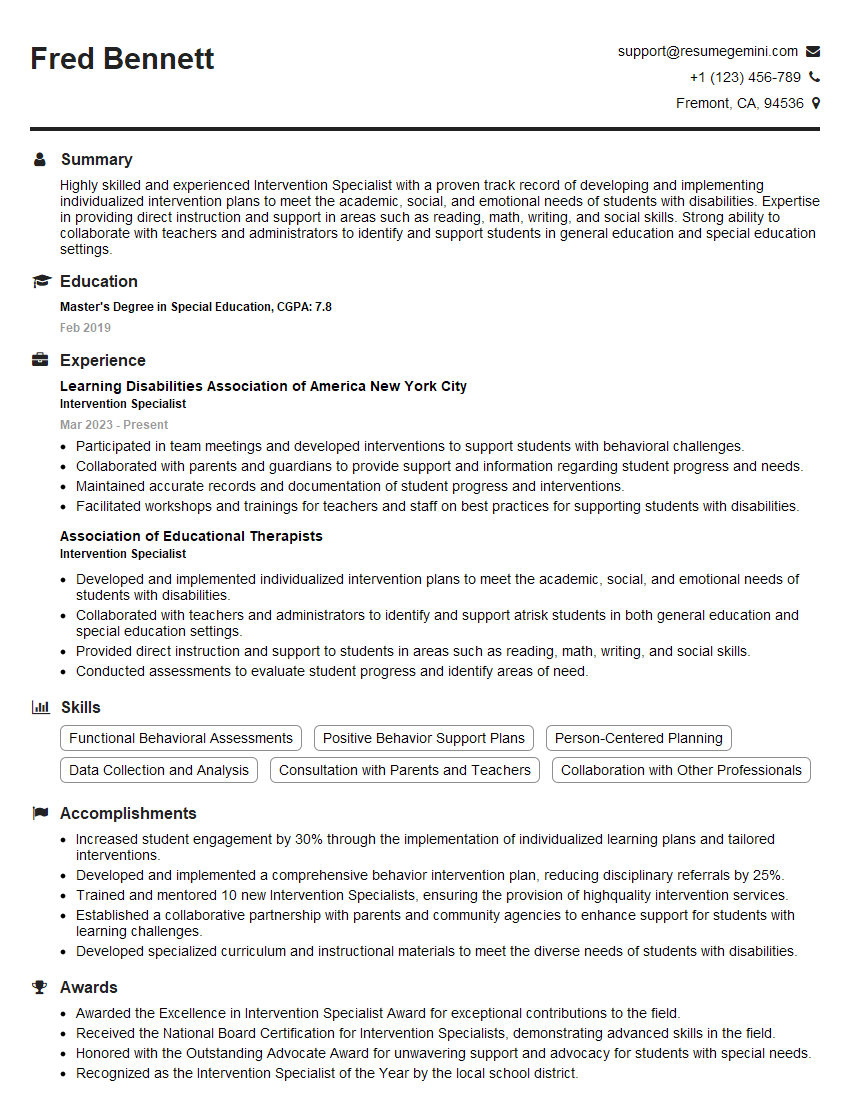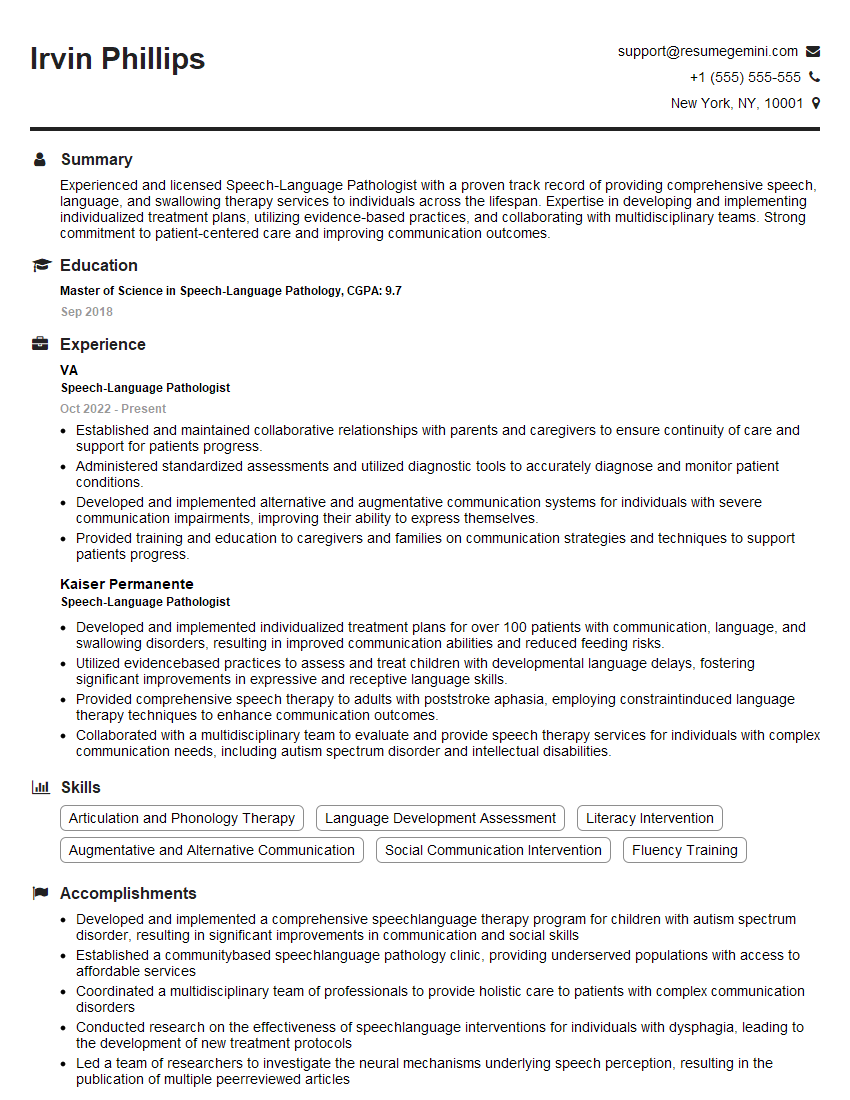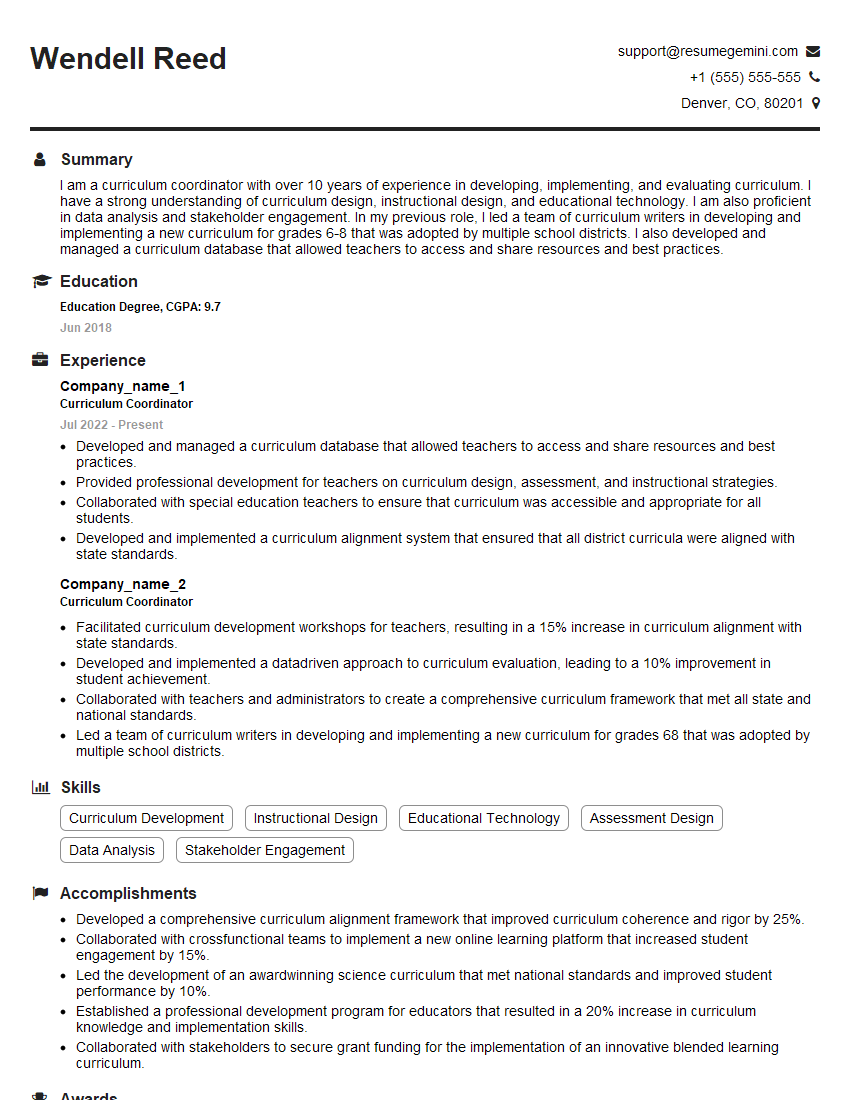The right preparation can turn an interview into an opportunity to showcase your expertise. This guide to Differentiated Instruction and Individualized Education Plans interview questions is your ultimate resource, providing key insights and tips to help you ace your responses and stand out as a top candidate.
Questions Asked in Differentiated Instruction and Individualized Education Plans Interview
Q 1. Explain the principles of differentiated instruction.
Differentiated instruction is a teaching approach that recognizes that students learn at different paces and in different ways. Instead of a one-size-fits-all approach, it tailors instruction to meet individual student needs. The core principles revolve around providing choices, offering varied learning experiences, and focusing on student strengths. It’s about creating a flexible learning environment that accommodates diverse learners. Think of it like a tailor making a suit – a standard template is adapted to fit the unique dimensions of each customer.
- Content: This refers to what students learn. Differentiation might involve offering varied reading levels, providing different complexity of assignments, or utilizing different types of materials (videos, articles, simulations).
- Process: This refers to how students learn. Differentiating process involves offering different ways to approach the same learning goal. For example, some students might prefer group work, others independent work, and some might benefit from one-on-one tutoring.
- Product: This refers to how students demonstrate their learning. Different students might show mastery in different ways: a written essay, a presentation, a project, a performance, or a portfolio.
- Learning Environment: Creating a classroom climate that is welcoming, inclusive, and supports risk-taking is crucial. This includes structuring the classroom to accommodate different learning styles and needs, providing clear expectations, and fostering positive relationships between students and teachers.
Q 2. Describe three different strategies for differentiating instruction based on student learning styles.
Differentiating based on learning styles is a key aspect of differentiated instruction. Here are three strategies:
- Visual Learners: For students who learn best through seeing, I might use graphic organizers, diagrams, mind maps, videos, and colorful presentations. For example, when teaching about the water cycle, I’d use a visually appealing diagram and a short animated video instead of just a text-based explanation.
- Auditory Learners: Students who learn best through hearing benefit from lectures, discussions, audio recordings, and read-alouds. To explain the water cycle, I might incorporate a lively classroom discussion, use a podcast about water conservation, or have students create their own audio explanations.
- Kinesthetic Learners: Hands-on activities, experiments, role-playing, and movement-based learning are ideal for kinesthetic learners. To teach the water cycle, we could conduct an experiment demonstrating evaporation and condensation, build a model of the water cycle using different materials, or create a role-play about the impact of water pollution.
Q 3. How do you adapt your instruction to meet the needs of students with IEPs?
Adapting instruction for students with IEPs requires careful consideration of their individual needs as outlined in their plans. This involves collaborating closely with the IEP team to understand the student’s strengths, weaknesses, and accommodations. Instruction might be modified in several ways:
- Modified Assignments: This could involve adjusting the length, difficulty, or format of assignments to match the student’s capabilities. For example, reducing the number of questions on a test or allowing extended time.
- Assistive Technology: Utilizing assistive technology like text-to-speech software, graphic organizers, or specialized keyboards can greatly support some students’ learning.
- Specialized Instruction: This might involve providing direct, targeted instruction in areas where the student struggles, such as using visual aids to teach math concepts.
- Accommodations in Assessment: Modifications to assessments, such as providing oral tests, alternative formats for showing understanding, or adjusting the testing environment.
It’s crucial to remember that adaptations should focus on providing access to the curriculum, not lowering expectations.
Q 4. What are the key components of an effective IEP?
An effective IEP includes several key components working in tandem to ensure a student’s success:
- Present Levels of Performance (PLP): A detailed description of the student’s current academic, social, and behavioral functioning.
- Goals and Objectives: Measurable, achievable goals and objectives that address the student’s identified needs.
- Services: A description of the specific services and supports the student will receive (e.g., tutoring, speech therapy, occupational therapy).
- Accommodations and Modifications: Strategies to help the student access the curriculum and participate in the learning environment.
- Evaluation Procedures: A plan for monitoring progress and making adjustments to the IEP as needed.
- Parent and Teacher Participation: Active participation and collaboration among parents, teachers, related service providers, and the student (when appropriate).
Q 5. How do you ensure that all students, including those with IEPs, are actively engaged in learning?
Keeping all students engaged, particularly those with IEPs, requires a multifaceted approach. It’s about tapping into their individual interests and strengths while providing appropriate support and challenges:
- Choice and Autonomy: Offering students choices in assignments, projects, and learning activities increases engagement. For example, allowing them to choose between writing a report or creating a presentation.
- Relevant and Engaging Content: Connecting learning to real-world applications, student interests, and current events enhances engagement. For example, using a case study relevant to their community to teach a math concept.
- Collaborative Learning: Group work and peer interaction foster engagement by providing opportunities for social interaction and peer support.
- Frequent Feedback and Positive Reinforcement: Regular feedback helps students track their progress and stay motivated, while positive reinforcement boosts confidence and encourages persistence.
- Differentiated Instruction: Utilizing differentiated instruction ensures that activities and assessments are appropriately challenging and accessible for all students.
Q 6. Describe your experience writing and implementing IEPs.
I have extensive experience in writing and implementing IEPs. I’ve worked with students across diverse age groups and with a wide range of disabilities. My approach emphasizes collaboration with the IEP team to develop individualized goals that are both ambitious and attainable. I focus on using data to inform the IEP process – tracking student progress to ensure the plan is effective and making adjustments as needed. For example, I’ve worked with a student with ADHD who struggled with focus and organization. We developed an IEP with strategies such as providing a quiet workspace, breaking down tasks into smaller steps, and using visual timers to manage time. Through consistent implementation and monitoring, this student showed significant improvement in their academic performance and organizational skills.
Q 7. How do you collaborate with parents and other professionals to support students with IEPs?
Collaboration is paramount in supporting students with IEPs. I actively engage parents and other professionals through:
- Regular Communication: Frequent updates, progress reports, and informal communication through email, phone calls, or meetings.
- Team Meetings: Participating in IEP meetings to collaboratively develop, review, and revise the IEP.
- Shared Decision-Making: Working collaboratively with parents, related service providers, and administrators to develop and implement interventions.
- Parent Involvement in the Classroom: Involving parents in classroom activities or providing opportunities for them to volunteer can enhance learning and communication.
- Open Communication Channels: Maintaining open and honest communication to address any concerns or questions proactively.
For example, I regularly communicate with parents about a student’s progress in class, and then work with the speech therapist and occupational therapist to make sure that the intervention we have in place at school is consistent with the therapy they receive outside of school. This holistic approach guarantees consistent progress and a supportive learning environment.
Q 8. How do you assess student progress toward IEP goals?
Assessing student progress toward IEP goals requires a multifaceted approach that goes beyond simply looking at grades. We need to regularly monitor the student’s performance across various assessment types to ensure that they are making adequate progress toward their individualized goals. This includes formative assessments, summative assessments, and informal observations.
Formative Assessments: These ongoing assessments, such as classwork, homework, quizzes, and exit tickets, provide continuous feedback and inform instructional adjustments. For example, if a student is consistently struggling with a particular math concept during practice problems, it signals a need to revisit the concept using different strategies or learning aids.
Summative Assessments: These end-of-unit or end-of-term tests provide a snapshot of overall learning. Analyzing student performance on these assessments, comparing it with baseline data, and noting areas of strength and weakness helps pinpoint where interventions are needed.
Informal Observations: These are equally important. Observing the student’s engagement in class, their participation in group activities, and their ability to apply learned skills in real-world scenarios offers valuable insights into their progress. For instance, if a student demonstrates strong understanding during class discussions but struggles with written assignments, this suggests a need for modifications in assessment methods.
Data Analysis: Regularly analyzing data from all these assessments – and comparing it against the IEP goals – allows us to track progress, identify areas needing improvement, and modify interventions as necessary. This data-driven approach is crucial to ensuring student success.
Q 9. How do you modify assessments for students with IEPs?
Modifying assessments for students with IEPs involves adapting the assessment format, content, or administration to better reflect their individual learning needs. The modifications should always be aligned with the student’s IEP goals and ensure accurate measurement of their skills and knowledge without penalizing them for their disability.
Format Modifications: This could involve changing the presentation of the material. For instance, providing large-print versions of tests, using audio recordings instead of written tests for students with visual impairments, or allowing students to answer questions orally.
Content Modifications: This focuses on adjusting the complexity or scope of the assessment. For instance, reducing the number of items on a test, providing simpler questions, or providing additional time to complete the assessment.
Administration Modifications: This might involve changing how the assessment is given. For example, allowing the student to use assistive technology, providing a quiet testing environment, or breaking the assessment into smaller sections over multiple days.
Example: A student with dyslexia might receive modifications like extended time, use of a computer for writing, and allowed to use a graphic organizer to help organize their thoughts before writing an essay. These modifications do not alter what the assessment measures; rather they allow the student to better demonstrate their knowledge and skills.
Q 10. What are some common accommodations and modifications used in differentiated instruction?
Differentiated instruction utilizes a variety of accommodations and modifications to cater to diverse learners. Accommodations don’t alter the content, but they change *how* students access the material. Modifications, on the other hand, change the actual content or expectations.
Common Accommodations:
- Extended Time: Allowing additional time for completing assignments or assessments.
- Alternative Assessment Formats: Offering options like oral exams, projects, or portfolios instead of traditional written tests.
- Assistive Technology: Providing tools like text-to-speech software, graphic organizers, or speech-to-text software.
- Preferential Seating: Allowing students to sit where they learn best (e.g., closer to the teacher, away from distractions).
- Modified Directions: Simplifying or clarifying instructions.
Common Modifications:
- Reduced Assignments: Assigning a smaller number of problems or questions.
- Modified Content: Simplifying complex texts, breaking down tasks into smaller steps.
- Alternative Curriculum: Providing a different curriculum or learning objectives entirely, based on individual learning needs.
- Different Learning Goals: Setting different, more attainable goals for a student to work toward.
Q 11. Explain the difference between accommodations and modifications.
The key difference between accommodations and modifications lies in their impact on the learning content and expectations. Accommodations change *how* a student learns the material without altering the content or the learning goals. Think of them as adjustments to the learning environment or process. Modifications, however, change the *what* – the actual content or the performance expectations. They alter the learning goals to better meet the student’s needs.
Analogy: Imagine a race. An accommodation might be giving a runner a lighter backpack, allowing them to run at their full potential without changing the course or distance. A modification might be shortening the race distance to better match the runner’s abilities. Both support the runner, but they address different aspects of their participation.
Q 12. How do you differentiate instruction for students with different levels of readiness?
Differentiation based on readiness involves providing learning experiences tailored to students’ current skill levels. This could involve grouping students based on their understanding of a concept or assigning tiered assignments where students work on tasks that are appropriately challenging. This approach prevents boredom for advanced learners and provides additional support for those who need it.
Tiered Assignments: Creating assignments with varying levels of complexity allows students to work at a level that best suits their current understanding. For example, a lesson on fractions might have one tier focusing on basic addition and subtraction, a second tier working on multiplication and division, and a third tier involving more complex problem-solving scenarios.
Flexible Grouping: Grouping students based on their readiness for a specific skill ensures that all students have access to instruction that meets their needs. This could be homogeneous grouping (students of similar skill levels together) or heterogeneous grouping (students of different skill levels working together).
Choice Boards: Providing students with options of activities at different levels of difficulty that will allow them to work on the concepts at a pace and depth that is appropriate for them. Students get to choose what is best for their readiness level.
Q 13. How do you differentiate instruction for students with different interests?
Differentiating instruction based on student interests involves providing choices in learning activities that allow students to pursue topics that genuinely engage them. This approach taps into students’ intrinsic motivation, leading to increased engagement and deeper learning.
Student Choice in Projects: Instead of assigning a single project, offer a variety of project options related to the unit of study. For instance, in a history unit on the American Revolution, students could choose to create a documentary, write a historical fiction story, design a museum exhibit, or give a presentation.
Interest Centers: Creating learning centers focused on different aspects of the subject matter allows students to explore their interests in more depth. For a science unit on ecosystems, one center might focus on marine life, another on forests, and another on deserts, allowing students to explore their preferred area of interest.
Independent Research Projects: Students can be allowed to independently research a topic of interest within a specified area that is relevant to the curriculum. This allows for self-directed learning and fulfillment of intrinsic motivation.
Q 14. How do you differentiate instruction for students with different learning profiles?
Differentiating instruction for students with different learning profiles recognizes that students learn in various ways. Some students are visual learners, others auditory, and still others kinesthetic. Catering to these differences involves using a variety of instructional methods that cater to each learning style.
Visual Learners: Use visuals like diagrams, charts, graphs, videos, and real-world objects to present information.
Auditory Learners: Incorporate lectures, discussions, and audio recordings. Think class discussions, oral presentations, podcasts, and audiobooks.
Kinesthetic Learners: Use hands-on activities, role-playing, experiments, and movement-based learning. This might include manipulatives, group activities, creating models, or acting out scenarios.
Multimodal Instruction: The most effective approach frequently involves combining multiple learning modalities within a single lesson. For example, a lesson on the solar system could involve a video presentation (visual), a discussion about planetary characteristics (auditory), and creating a 3D model of the solar system (kinesthetic).
Q 15. Describe a time you had to adapt an IEP to meet a student’s changing needs.
Adapting an IEP requires a collaborative and data-driven approach. IEPs, or Individualized Education Programs, are tailored to a student’s unique needs. However, a student’s needs can evolve. I remember a student, let’s call him Alex, who initially had an IEP focused on reading comprehension. His IEP included strategies like graphic organizers and pre-teaching vocabulary. As the year progressed, we noticed Alex was struggling with organization and time management, impacting his ability to complete assignments even when he understood the material. This wasn’t explicitly addressed in his initial IEP.
Through ongoing assessments—including classroom observations, teacher feedback, and standardized tests—we identified the organizational challenges as a significant barrier to his academic success. We convened an IEP meeting with Alex’s parents, special education teacher, general education teacher, and myself. We collaboratively revised his IEP to include specific strategies for improving his organizational skills. This involved adding goals related to time management, providing visual schedules, and implementing organizational tools like planners and color-coded folders. The changes were gradual, closely monitored, and Alex was actively involved in the process (as discussed in a later answer). We also adjusted his assignments, breaking down larger projects into smaller, more manageable chunks. The revised IEP resulted in a significant improvement in Alex’s ability to complete assignments and ultimately, his academic performance.
Career Expert Tips:
- Ace those interviews! Prepare effectively by reviewing the Top 50 Most Common Interview Questions on ResumeGemini.
- Navigate your job search with confidence! Explore a wide range of Career Tips on ResumeGemini. Learn about common challenges and recommendations to overcome them.
- Craft the perfect resume! Master the Art of Resume Writing with ResumeGemini’s guide. Showcase your unique qualifications and achievements effectively.
- Don’t miss out on holiday savings! Build your dream resume with ResumeGemini’s ATS optimized templates.
Q 16. How do you use data to inform your differentiated instruction?
Data is the cornerstone of effective differentiated instruction. It’s not just about grades; it’s about a holistic understanding of each student’s strengths and weaknesses. I use a variety of data sources to inform my teaching. This includes formative assessments (like exit tickets and quizzes), summative assessments (tests and projects), observation notes from classroom activities, and even informal data from student self-assessments and anecdotal records.
For example, if my formative assessments reveal that a group of students struggles with a specific concept, I know to adjust my instruction. Perhaps I need to re-teach the concept using different methods, provide additional practice activities, or offer more scaffolding. Similarly, data from summative assessments helps me evaluate the effectiveness of my differentiated instruction and identify areas where further adjustments may be needed. I regularly analyze this data to understand patterns and tailor my instruction to meet individual learning styles and needs.
Q 17. How do you ensure that your differentiated instruction is equitable for all students?
Equitable differentiated instruction isn’t about treating all students the same; it’s about ensuring all students receive the support they need to succeed. This means considering the diverse needs of all learners—including students with disabilities, gifted students, and English language learners—and providing appropriate accommodations and modifications to meet their unique needs. It’s crucial to avoid creating a system where certain student groups receive less attention or challenging assignments.
For example, when differentiating, I make sure to offer choices in assignments. Some students may benefit from working individually, others in small groups, and others might thrive through collaborative projects. I also provide various formats for assessments: some students might excel with written tests, others with oral presentations, and others might benefit from a hands-on project. Crucially, I use high-quality resources and materials that reflect the diversity of my students and foster a classroom where all feel valued and respected.
Q 18. How do you involve students in the process of setting IEP goals?
Student involvement in the IEP goal-setting process is vital. It fosters a sense of ownership and increases the likelihood of success. I always start by having conversations with the student to understand their strengths, weaknesses, and aspirations. I explain the purpose of the IEP in age-appropriate terms, making it clear that the goals are designed to help them reach their full potential.
I involve them in brainstorming potential goals. For example, instead of simply stating a goal of improving reading comprehension, we might collaboratively define specific, measurable, achievable, relevant, and time-bound (SMART) goals. We might decide on a goal like ‘Increase reading comprehension by two grade levels as measured by standardized tests within one year.’ I also explain what each intervention will look like, encouraging them to participate in selecting the strategies they feel are most likely to be effective. This active participation ensures the IEP is not just a document, but a collaborative effort towards the student’s academic and personal growth.
Q 19. What are some common challenges in implementing differentiated instruction and IEPs?
Implementing differentiated instruction and IEPs presents several common challenges. One major hurdle is the time commitment required for planning and preparation. Creating varied instructional materials and individualized assessments takes significant time and effort. Another challenge is access to resources. Schools may lack the necessary materials, technology, or support staff to effectively implement differentiated instruction for all students. Furthermore, a lack of consistent professional development can leave teachers feeling unprepared and unsure about the best strategies to use.
Another significant challenge is balancing the needs of all students in a diverse classroom. Managing various learning styles, paces, and needs simultaneously can be overwhelming. Finally, effective communication with parents and other stakeholders is essential, but it can be difficult to coordinate and keep everyone informed about a student’s progress and the changes made to their IEP.
Q 20. How do you overcome these challenges?
Overcoming these challenges requires a multifaceted approach. Effective time management is crucial; prioritizing tasks and leveraging resources like pre-made materials can save time. Collaboration with colleagues is essential to share resources, lesson plans, and best practices. Advocating for additional resources from the school administration is necessary to ensure access to the materials and support needed. Regular professional development helps educators stay updated on effective strategies for differentiated instruction.
To address the challenge of balancing student needs, clear organization and planning are crucial. Creating a flexible schedule and utilizing various teaching strategies and assessment tools helps meet different learning styles and needs. Finally, establishing open communication with parents through regular meetings, emails, or newsletters, coupled with effective documentation of progress, helps ensure everyone is informed and actively involved in the student’s success.
Q 21. What resources do you use to support your differentiated instruction?
I utilize a wide range of resources to support my differentiated instruction. These include curriculum materials designed for diverse learners, online resources offering interactive activities and games, and educational technology platforms providing adaptive learning experiences. I also rely on specialized assessment tools that help me identify students’ specific learning needs and monitor their progress.
I frequently consult professional journals and research articles to stay informed on best practices and evidence-based strategies. Collaboration with colleagues and participation in professional development workshops play an essential role in expanding my knowledge and improving my teaching. Ultimately, my most valuable resource is the ongoing feedback and collaboration with students, their parents, and other professionals involved in their education. These interactions provide the most valuable insights for refining my instruction and ensuring I provide the best support for each student’s unique learning journey.
Q 22. How do you use technology to support differentiated instruction and IEPs?
Technology is an invaluable tool in both differentiated instruction and IEP implementation. It allows for personalized learning experiences catering to diverse learning styles and needs.
- For Differentiated Instruction: I utilize online learning platforms like Khan Academy or IXL to provide students with customized practice based on their individual skill levels. For example, a student struggling with fractions might receive targeted practice on specific fraction types, while a more advanced student can move on to more complex problems. Interactive simulations and educational games can also make learning more engaging and cater to visual or kinesthetic learners. I use learning management systems (LMS) like Google Classroom to provide differentiated assignments, resources, and feedback, ensuring that each student receives materials appropriate to their abilities.
- For IEPs: Assistive technology is crucial. For students with dyslexia, I might use text-to-speech software or speech-to-text software. For students with visual impairments, screen readers and screen magnifiers are essential. I also leverage adaptive learning platforms that adjust difficulty based on student performance, making the learning process more accessible and successful.
Think of it like a toolbox – different tools for different jobs. Technology provides the tools to build personalized learning experiences tailored to each student’s needs.
Q 23. Describe your experience using assistive technology to support students with disabilities.
My experience with assistive technology spans several years and a variety of disabilities. I’ve worked with students using a wide range of tools. For instance, I’ve supported students with:
- Visual impairments: Utilizing screen readers like JAWS and NVDA, and screen magnification software to enlarge text and images.
- Auditory processing disorders: Employing noise-canceling headphones and assistive listening devices to minimize distractions and enhance auditory clarity. I also frequently leverage captioned videos and transcripts.
- Physical disabilities: Using alternative input devices like switch access for students with limited motor skills, allowing them to interact with computers and tablets.
- Learning disabilities: Implementing text-to-speech software, graphic organizers, and mind-mapping tools to support comprehension and organization.
In each case, the key is careful assessment of the student’s individual needs and a trial-and-error approach to finding the most effective technology. It’s not just about providing the technology, but also about teaching the student how to use it effectively and integrating it seamlessly into their learning routine.
Q 24. How do you communicate effectively with parents about their child’s IEP?
Effective communication with parents is paramount for IEP success. I prioritize open, honest, and regular communication.
- Regular Meetings: I schedule regular meetings (at least twice a year, or more frequently as needed) to discuss the student’s progress, challenges, and any necessary adjustments to the IEP. I always begin by discussing the student’s strengths before addressing areas for improvement.
- Progress Reports: I provide frequent, detailed progress reports, using clear and simple language that avoids educational jargon. I use data, both qualitative (observations) and quantitative (test scores) to support my assessments. I also include positive anecdotal evidence of the student’s accomplishments.
- Multiple Communication Channels: I use a variety of methods for communication, including email, phone calls, and parent-teacher conferences, ensuring parents can choose the method most convenient for them.
- Collaborative Goal Setting: I involve parents in the IEP goal-setting process, making sure they understand the goals and how they will be measured. This fosters a sense of shared responsibility and commitment.
Building a strong, trusting relationship with parents is key. Their insights into their child’s strengths, weaknesses, and preferences are invaluable in tailoring the IEP for maximum effectiveness. I ensure that every communication is respectful and child-centered.
Q 25. How do you ensure that IEP goals are aligned with general education curriculum?
Alignment between IEP goals and the general education curriculum is crucial for inclusion and success. The IEP shouldn’t create a separate learning path but rather provide support to access the general education curriculum.
- Curriculum Review: I thoroughly review the general education curriculum to identify the key skills and concepts that the student needs to master. I then use this information to develop IEP goals that are directly related to these curriculum standards.
- Differentiated Instruction within the General Curriculum: The IEP goals will detail how the student will access and meet these standards. This might involve providing modified assignments, extra support, or alternative assessment methods, but it should always focus on allowing the student to participate in the same curriculum as their peers.
- Collaboration with General Education Teachers: Close collaboration with the general education teacher is essential. We work together to develop strategies for integrating the student into the classroom and ensuring that they receive the support they need to participate fully.
- Regular Monitoring: Continuous monitoring and adjustments are necessary to ensure the IEP goals remain aligned with the general education curriculum and the student’s progress.
Think of it as building a bridge – the IEP provides the support necessary to help the student successfully cross over to the general curriculum, not a separate destination.
Q 26. What is your experience with various assessment methods (formative & summative)?
I utilize a variety of assessment methods – both formative and summative – to gain a comprehensive understanding of each student’s progress.
- Formative Assessments: These are ongoing assessments used to monitor student learning during instruction. Examples include:
- Observations: Observing student participation in class discussions and activities.
- Checklists: Using checklists to track student progress on specific skills.
- Exit Tickets: Asking students to answer a few quick questions at the end of a lesson.
- Quizzes: Using short, informal quizzes to assess understanding.
- Summative Assessments: These are end-of-unit or end-of-term assessments used to evaluate overall learning. Examples include:
- Tests: Using standardized tests and classroom tests to measure mastery of key concepts.
- Projects: Assigning projects that allow students to demonstrate their understanding in creative ways.
- Portfolios: Having students collect their work in a portfolio to showcase their growth over time.
The choice of assessment methods is dependent on the student’s individual needs and the learning objective. I ensure that the assessments are accessible and equitable for all students, and I always consider alternative assessment methods to account for differing learning styles and abilities.
Q 27. How do you ensure that all students have access to the general education curriculum?
Universal Design for Learning (UDL) is a key framework for ensuring access to the general education curriculum for all students. This framework focuses on creating flexible learning environments that cater to diverse learners.
- Multiple Means of Representation: Providing information in various formats (visual, auditory, kinesthetic) to accommodate different learning preferences. For example, providing both written instructions and visual aids, or using audio books alongside text.
- Multiple Means of Action and Expression: Offering various ways for students to demonstrate their learning. This might include oral presentations, written assignments, projects, or performances.
- Multiple Means of Engagement: Designing lessons that are motivating and relevant to students’ interests and experiences. This involves creating a supportive classroom environment that fosters collaboration and allows for student choice and autonomy.
- Assistive Technology and Accommodations: As previously mentioned, providing assistive technology and appropriate accommodations is crucial for ensuring that students with disabilities have equal access to the curriculum.
By applying UDL principles, we can create a classroom where all students feel valued, supported, and challenged, regardless of their learning style or abilities. It’s about making the curriculum accessible to all, not about lowering standards.
Key Topics to Learn for Differentiated Instruction and Individualized Education Plans Interview
- Understanding Differentiated Instruction: Explore the core principles of differentiated instruction, including catering to diverse learning styles, readiness levels, and interests. Consider the various models and strategies used in practice.
- Developing Individualized Education Plans (IEPs): Learn the legal framework surrounding IEPs, the process of IEP development (including assessment, goal setting, and service delivery), and the collaborative nature of IEP teams.
- Assessment and Data-Driven Instruction: Understand the role of formative and summative assessments in informing differentiated instruction and IEP goals. Explore how data analysis informs instructional decisions and modifications.
- Adapting Curriculum and Instruction: Focus on practical strategies for adapting curriculum and instructional materials to meet individual student needs, including modifications and accommodations.
- Collaboration and Communication: Master effective communication strategies with parents, students, administrators, and other professionals involved in supporting students with IEPs. Understand the importance of building strong collaborative relationships.
- Technology Integration: Explore how technology can be used to differentiate instruction and support students with diverse learning needs. Consider assistive technology and other tools.
- Addressing Diverse Learning Needs: Gain a deep understanding of various learning disabilities, giftedness, and other exceptionalities. Learn how to effectively adapt instruction for students with these needs within an inclusive classroom setting.
- Monitoring Progress and Evaluating Effectiveness: Learn how to track student progress towards IEP goals and how to make data-driven adjustments to instruction and interventions. Understand the importance of ongoing evaluation.
Next Steps
Mastering Differentiated Instruction and Individualized Education Plans is crucial for career advancement in education. Demonstrating expertise in these areas significantly increases your marketability and allows you to make a real difference in the lives of your students. To boost your job prospects, creating a strong, ATS-friendly resume is essential. ResumeGemini is a trusted resource that can help you build a professional resume showcasing your skills and experience effectively. Examples of resumes tailored to highlight expertise in Differentiated Instruction and Individualized Education Plans are available to guide your resume creation process.
Explore more articles
Users Rating of Our Blogs
Share Your Experience
We value your feedback! Please rate our content and share your thoughts (optional).
What Readers Say About Our Blog
There are no reviews yet. Be the first one to write one.
